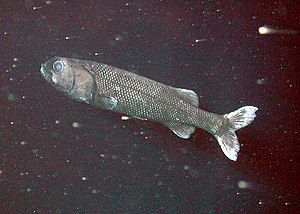Alepocephaliformes
| Alepocephaliformes | ||||||||||||
|---|---|---|---|---|---|---|---|---|---|---|---|---|

Alepocephalus tenebrosus at 1,551 meters above the Davidson Seamount off the coast of California |
||||||||||||
| Systematics | ||||||||||||
|
||||||||||||
| Scientific name | ||||||||||||
| Alepocephaliformes | ||||||||||||
| Marshall , 1962 |
The Alepocephaliformes (formerly Alepocephaloidei ; Gr .: "A" - = without, "lepos" = scale, "cephale" = head), German smooth-headed fish, are a group of deep-sea fish that are found in all oceans worldwide. They usually live at depths between 1,000 and 6,000 meters.
The Alepocephaliformes were initially related to the herring (Clupeidae), later assigned as a subordination to the golden salmon-like (Argentiniformes). More recent studies on the basis of DNA analyzes return to the further herring relationship and position the Alepocephaliformes in their own sub-cohort Alepocephali of the Ostarioclupeomorpha , which also includes the herring-like (Clupeiformes) and the Ostariophysi , the most species-rich taxon of freshwater fish .
features
In contrast to many other deep-sea fish, the Alepocephaliformes have a "normal" fish shape. Their length is in most cases between 20 and 50 cm, only a few species remain smaller, the largest species grows to around a meter. The Alepocephaliformes have no adipose fin and swim bladder . Your dorsal fin sits behind the center of your body. The mouth is big. The Alepocephaliformes are mostly dark in color (some are also light), their eggs are relatively large. The two parietal bones are separated from each other by the supraoccipital. The posterior temporal bone (post-temporal) is not indented. Branchiostegal cartilage is present. The upper (dorsal) part of the gill cover is reduced. The postcleithrum, a bone of the shoulder girdle, is only present once. The urodermal bone present in many groups of fish, a pair of thin skin bones on the dorsal side of the caudal fin skeleton, formed from scales, is missing.
The author of the first description , Norman Bertram Marshall , gave the following characteristics for the Alepocephaliformes:
- missing swim bladder .
- small pectoral fins that start relatively low down.
- a reduction or a complete lack of scaling.
- the attachment of the dorsal fin is close, but always behind the middle of the standard length , opposite the anal fin .
- usually 7 to 9 Branchiostegal rays .
Internal system
Three families with 39 genera and about 130 species are currently recognized.
- Blackheads family (Alepocephalidae)
- Bathylaconidae family
- Light herrings family (Platytroctidae)
The Platytroctidae occupy a basal position and are the sister group of all other Alepocephaliformes.
The following cladogram shows the internal system:
| Alepocephaliformes |
|
||||||||||||||||||||||||||||||
|
|
Current phylogenetic studies confirm the monophyly, but not the basal position of the Platytroctidae. This makes the Alepocephalidae paraphyletic , so that the subdivision of the Alepocephaliformes into the previous three families should not continue.
External system
In the past, the Alepocephaliformes were initially placed with the herrings (Clupeidae) in the suborder Clupeoidea (order Isospondyli), later as suborder Alepocephaloidei to the golden salmon-like (Argentiniformes) and should thus be included in the further relationship of the salmon- like , smelt-like and pike-like , the Protacanthopterygii , belong. New cladistic studies position them as a sister group of the Ostariophysi , the most species-rich freshwater fish taxon with the herring-like (Clupeiformes) in the further relationship, or, when comparing the mitochondrial DNA , basal to the Ostarioclupeomorpha, the group of herring-like and Ostariophysi.

The following " cladogram " (which mixes older classification and newer knowledge) shows the systematic position of the Alepocephaliformes and the old position as a subordination of the golden salmon-like:
| Clupeocephala |
|
||||||||||||||||||||||||||||||||||||||||||||||||||||||||||||||||||||||||
|
|
Tribal history
The fossil record of the Alepocephaliformes is sparse. Only one species, Carpathichthys polonicus from the Oligocene of Poland , is known. It resembles the recent genus Rouleina and, like this one, is assigned to the family Alepocephalidae.
swell
- ↑ Wissenschaft-online.de: Smooth-headed fish
- ↑ Alepocephalus bairdii on Fishbase.org (English)
- ↑ a b c d Joseph S. Nelson : Fishes of the World , John Wiley & Sons, 2006, ISBN 0-471-25031-7
- ^ EO Wiley & G. David Johnson: A teleost classification based on monophyletic groups. Pages 123-182 in Joseph S. Nelson , Hans-Peter Schultze & Mark VH Wilson: Origin and Phylogenetic Interrelationships of Teleosts. 2010, Verlag Dr. Friedrich Pfeil, Munich, ISBN 978-3-89937-107-9 .
- ↑ a b Jørgen G. Nielsen & Verner Larsen: Synopsis of the Bathylaconidae (Pisces, Isospondyli) with a new eastern Pacific species. Galathea rept. 9: 221-238, pls. 13-15. PDF
- ↑ a b Jan Poulsen et al .: Higher and lower-level relationships of the deep-sea fish or Alepocephaliformes (Teleostei: Otocephala) inferred from whole mitogenome sequences. ( Memento of December 5, 2015 in the Internet Archive ) Biological Journal of the Linnean Society, 2009, 98, 923-936 (PDF).
- ↑ Ricardo Betancur-R., Richard E. Broughton, Edward O. Wiley, Kent Carpenter, J. Andrés López, Chenhong Li, Nancy I. Holcroft, Dahiana Arcila, Millicent Sanciangco, James C Cureton II, Feifei Zhang, Thaddaeus Buser, Matthew A. Campbell, Jesus A Ballesteros, Adela Roa-Varon, Stuart Willis, W. Calvin Borden, Thaine Rowley, Paulette C. Reneau, Daniel J. Hough, Guoqing Lu, Terry Grande, Gloria Arratia, Guillermo Ortí: The Tree of Life and a New Classification of Bony Fishes ( Memento of October 13, 2013 in the Internet Archive ). PLOS Currents Tree of Life. 2013 Apr 18 [last modified: 2013 Apr 23]. Edition 1. (PDF) doi: 10.1371 / currents.tol.53ba26640df0ccaee75bb165c8c26288
- ↑ Sébastien Lavoue et al .: Monophyly, phylogenetic position and inter-familial relationships of the Alepocephaliformes (Teleostei) based on whole mitogenome sequences ( Memento from November 28, 2015 in the Internet Archive ) Molecular Phylogenetics and Evolution 47 (2008) 1111–1121 ( PDF)
- ^ Richard E. Broughton: Phylogeny of teleosts based on mitochondrial genome sequences. in JS Nelson, H.-P. Schultze & MVH Wilson: Origin and Phylogenetic Interrelationships of Teleosts. © 2010 by Verlag Dr. Friedrich Pfeil, Munich, Germany - ISBN 978-3-89937-107-9




